Florida landowners have contributed vastly to the Southeast’s planting of pines over many decades. Recent incentive programs, such as the Longleaf Pine Private Landowner Incentive Program, https://www.fdacs.gov/Forest-Wildfire/For-Landowners/Grants/Forestry-and-Wildlife-Cost-Share-Programs, have encouraged further interest. Understanding the factors that affect pine seedling quality and survival will assure a more successful forest plantation, whether objectives focus on timber production, recreation, wildlife habitat, water quality protection, etc. (Nadel et al. 2020). Seven pine species (Pinus spp.) are considered to be native to Florida. These species are loblolly pine (P. taeda), longleaf pine (P. palustris), shortleaf pine (P. echinata), slash pine (P. elliottii), sand pine (P. clausa), spruce pine (P. glabra), and pond pine (P. serotina), and each varies in the site conditions where it grows as well as in its commercial utility and availability. We are going to talk about the importance of site selection and soils as they relate to each species, the landowners’ objectives, and their target markets. This publication is to be used as a guide to facilitate selection of appropriate pine species and offers guidance on best practices for handling seedlings throughout all stages of tree planting.
Soil Orders in Florida
Common soils of Florida include:
- the red clayey/loamy soils of the upper Florida Panhandle (Ultisols);
- the poorly drained, sandy soils of the flatwoods (Spodosols);
- the peat soils of the northern Everglades (Histosols); and
- the shallow, limerock-influenced soils of extreme south Florida (Entisols).
Figure 1shows the specific soil orders across the state, which are described in detail in Table 1.
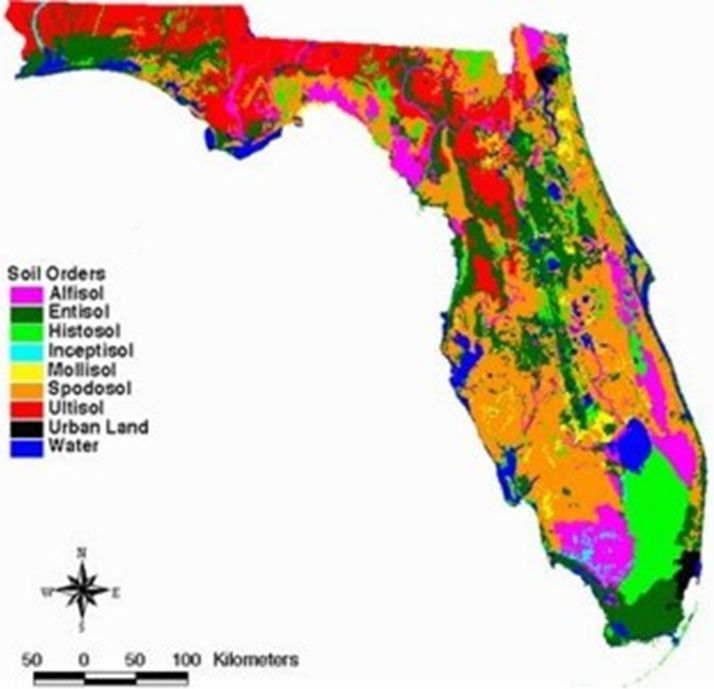
Credit: NRCS USDA Web Soil Survey
It is important to note that, in any planting, a site’s productive potential is a function of a relatively thin surface layer of soil. Thus, matching the species to the site is crucial. The properties and drainage of soil are very useful indicators for deciding which pine species would be best suited for a particular site. General soil–site conditions of Florida and pine species preference are summarized in Table 2.
Table 1.Soil orders commonly found in Florida.
Table 2.Florida soil-site relationships1.
For more information on soils of Florida, visit the Florida Land Steward website at https://programs.ifas.ufl.edu/florida-land-steward/forest-resources/soils/?web=1&wdLOR=c2E97A9AE-0AFF-4D71-8F0F-BE2B78A688F1.
Seedling Source
It’s not uncommon for landowners to buy seedlings from other states. However, seedlings produced out of state may not always be appropriate for some regions of Florida. The following guidelines will help you select a source for seedlings:
- Loblolly pine*. With genetic improvements, loblolly planting stock upholds a level of resistance to insects and diseases previously unheard of and can grow and survive across a wide range of site conditions. Some stock may be more appropriate in certain conditions, but generally seed origin is not a concern.
- Longleaf pine. Favor local sources.
- Sand pine. Favor local sources.
- Shortleaf pine. Favor local sources within the geographic region of the planting site.
- Slash pine*. Seedlings with demonstrated higher rust resistance ought to be sourced when planting on sites where fusiform rust is common; if these are unavailable, loblolly sources or improved longleaf pine sources may be used. Most importantly, avoid the Southern Slash variety (var. densa) for plantings north of Tampa, Florida, as the typical variety will perform much better. However, the southern slash variety should be considered for planting south of Tampa.
*Genetically improved options exist.
Seedling Type
For most pine species, seedlings can be purchased one of two ways: “bare-root” or “containerized.” Containerized seedlings are becoming increasingly more common in the South, particularly for longleaf pine for the benefit of its survival. Table 3 provides an overview of the advantages and disadvantages of bare-root and containerized seedlings to assist landowners with purchasing the most appropriate type, based on their objectives and available resources. Remember, planting containerized seedlings will not substitute for good quality site preparation. However, containerized seedlings can have better survival when planting on lower quality sites or sites with limited preparation as compared to bare-root seedlings.
Table 3.Comparison of bare-root vs. containerized seedlings.
Ordering Seedlings from Nurseries
Once you have selected the appropriate species for your site, you can order your seedlings directly from a nursery or through a vendor. A majority of private and state nurseries begin taking seedling orders as early as the spring before planting season and start filling the orders in the fall. Supplies for certain pine seedlings may not be sufficient to meet overall demands, so plan ahead by placing orders early to ensure you have seedlings to meet your planting needs. This also applies to species such as sand, pond, and shortleaf pine that are not commonly grown in commercial nurseries in Florida.
It is important to note that seedlings are often sold/shipped in different ways. For instance, bare-root seedlings may be bundled up and baled, leaving the seedlings susceptible to drying out; however, seedlings can also be bagged or boxed to better protect them from drying. Typically, fewer seedlings fit in boxes, which sometimes means that you will need a larger (and likely more expensive) transport vehicle. Unfortunately, the consumer rarely has a choice on how the seedlings will be sold.
As previously discussed, the geographical relevance will also be more important for some species over others. It’s important to note that local nurseries may be growing seedlings of pines sourced from other regions or from outside of the state. Never assume that the location you are purchasing seedlings from is where the seed was sourced. Be sure to ask nursery owners where seedlings originated. A map of Florida’s forest tree nurseries can be found in Figure 13 in the “selecting species” section, later in this publication.
Cost per Seedling
Prices of seedlings will vary year to year based on the supply/demand for desired pine species, bare-root vs. containerized, and standard vs. genetically improved seedlings. As of 2021, the typical price ranges for the Southeast region are as follows:
- Bare-root $60–90 per 1,000 seedlings ($0.06–0.09 per seedling)
- Containerized $160–200 per 1,000 seedlings ($0.16–$0.20 per seedling)
Nurseries typically charge for delivery of seedlings. For example, Andrews Nursery (Florida Forest Service) will charge $10 per 1,000 seedlings ordered; for a sample of prices by seedling type, visit the Florida Department of Agriculture and Consumer Services website at https://www.fdacs.gov/Forest-Wildfire/For-Landowners/Programs-for-Landowners/Tree-Seedlings-for-Sale/Pricing-for-Tree-Seedlings.
Seedling Quality and Storage
What constitutes a good-quality seedling?
Seedlings of good quality are those that are disease free, and easily planted and that meet the following specifications (Balmer and Williston 1974):
- Root collar diameter – no less than ¼” for longleaf, ⅛” for other species
- Root systems – no less than 5”
- Stem – stiff and woody, secondary needles present
- Top/stem length – max. 12” for most species
Factors affecting seedling quality and planting success include:
- Consideration of existing site conditions (planting in favorable environmental conditions)
- Planting technique
- Proper handling of seedlings during preparation (transportation and storage) and in the field
- Quality of seedlings at planting (e.g., seedlings that are deemed culls)
Grading Standards and Cull Seedlings
Before seedlings can be planted, they must meet certain grading standards to be deemed “plantable.” Grading before planting removes seedlings which are too long or short to plant, with broken or crushed roots and stems, missing bark, stripped roots or needles, stem swellings indicating fusiform rust, or other damage. Table 4 lists the minimum standards for plantable southern pine seedlings. To assist with understanding seedling morphology used in this table, refer to Figure 2 for a labelled loblolly bare-root seedling.
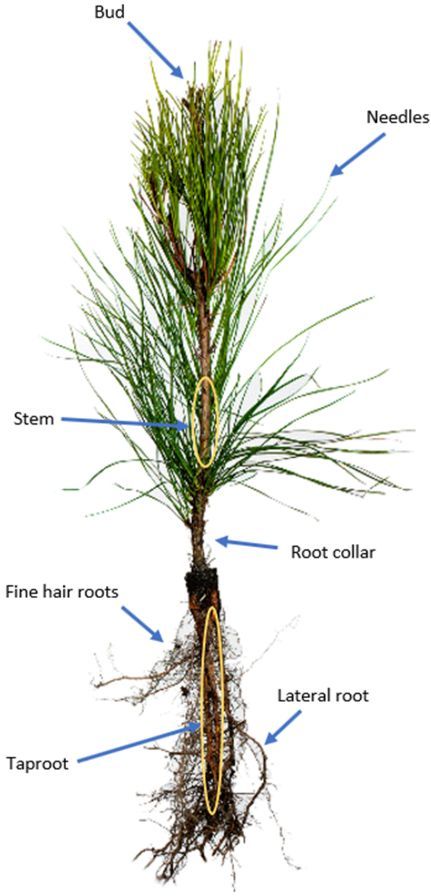
Credit: ArborGen
Table 4.Grading standards of pine seedlings1.
If the nursery did not grade and/or prune your seedlings before pickup/shipment, it may fall upon the plant contractors or planters to evaluate seedlings for culls before planting. Instruct planting crew members not to prune roots during the planting operation as roots may be stripped off, increasing risk of mortality. Roots should be pruned with a hatchet, machete, scissors, or shears with a single clean cut, removing as little of the root system as necessary.Current best practices at nurseries produce seedlings with good lateral root development and 6- to 8-inch taproots. To determine if additional root pruning has occurred in the field, check seedlings for short, freshly cut taproots (Londo and Dickie 2005).
Seedling Storage
Careful handling and storage are both important for seedling viability. Planting seedlings as soon as possible after you receive them is the best course of action (longleaf should be planted within a week because seedlings are extremely perishable). However, when storage is essential, store seedlings at 85–95% relative humidity and ensure they are protected from direct sun and high temperatures to prevent them from drying out; always allow for adequate air circulation around seedling containers. If opting to pick up seedlings from the nursery, consider cooler times of the day and provide shaded conditions to prevent heat buildup during transportation. Indicators of potential damage to seedlings include discolored roots, a sour smell, and mold. Avoid high temperatures, low humidity, and excess water.
In some cases, you may need to store seedlings due to unexpected delays (e.g., weather, personnel). If you are using bare-root seedlings and they cannot be stored in a climate-controlled situation (i.e., refrigeration), consider “heeling in” your seedlings. Simply dig a narrow trench, lay seedlings along the trench, and cover and lightly pack (heel in) the soil. This should help keep your seedling roots moist until conditions change to allow you to plant again, but may only be practical with a limited number of seedlings (fewer than 5000).
Planting Preparation
Site Preparation
Site preparation should optimize the amount of water, sunlight, and nutrients available to planted pines. Competition control is often the most important objective for site prep as pines often experience aggressive above ground and below ground root competition after planting. Landowners’ decisions for the type of site preparation will be governed by their goals and the condition of the site. For instance, on sites where soils are poorly drained, mechanical bedding may be warranted to ensure adequate seedling survival and growth as pine roots are typically shallow on such sites (Gilman et. al 2019b).
Types of site preparation include mechanical, chemical, prescribed burning, or a combination of these methods. For more details on each method, refer to NRCS’s Site Preparation guide, https://www.nrcs.usda.gov/Internet/FSE_DOCUMENTS/nrcs144p2_002293.pdf, and UF/IFAS publication Forest Management in the Interface: Reducing Fire Risk, https://edis.ifas.ufl.edu/publication/fr249. Additional considerations for chemical site preparation for silviculture operations can also be found here: https://edis.ifas.ufl.edu/publication/FR335.
Fertilization
Nutrients removed from previous harvests or prior land uses can also be replaced to supplement survival and growth of seedlings; fertilization can increase chip-n-saw and saw timber yields significantly (Taylor et al. 2007). However, nutrient replacement is not essential for every site. Landowner management goals, soils, and pre-fertilization stand conditions will dictate the need to fertilize. For more information on fertilization, visit the Florida Land Steward “Fertilization” page at https://programs.ifas.ufl.edu/florida-land-steward/forest-management/timber-management/fertilization/?web=1&wdLOR=cC327BA64-9AD8-4B26-BDD7-02FBAC976C06, and UF/IFAS publication Using Soils to Guide Fertilizer Recommendations for Southern Pines, https://edis.ifas.ufl.edu/publication/FR053.
Planting Conditions
Proper care and handling before and during planting is critical for seedling survival; seedlings can be exposed to the harshest weather conditions during these phases. Cool, moist conditions are best during the planting process. Seedlings are more likely to die when planted in the following conditions:
- bright, sunny, windy days—seedlings may dry out
- dry soils—difficult to pack around seedling roots
- extremely wet soils (especially clay)—machine planting may result in soil compaction around seedlings and additional site damage
- unsettled soil beds—these are characterized by air pockets in the soil that can limit root growth and even kill seedlings if their roots cannot reach water
Table 5 displays weather guidelines for planting southern pine tree seedlings. Whenever weather conditions are in the “critical” ranges, avoid or delay planting until conditions improve. Take extra care when planting in “marginal” conditions; have planters carry fewer seedlings if one of the weather conditions falls within the critical class.
Table 5. Weather guidelines for pine seedling planting1.
Without an established, written agreement, it may be difficult to limit the planting contractor to planting only during acceptable conditions. Consider including a statement in the contract addressing work stoppage during critical planting conditions.
Season
Seedlings are lifted from the nursery when they are dormant and planting season follows in late fall/early winter. Seedlings planted in fall have more time to acclimate to their planting site, recover from transplant injury, and establish healthy and vigorous root systems before the hot and dry summer months arrive (Taylor et al. 2007). Planting seedlings early enough also allows for enhanced seedling nutrition and root growth before bud break (new growth) occurs (Nadel et al. 2020).
Planting
Seedling care in the field is equally as important as the care and protection provided during transport and storage. To prevent seedlings from drying out and keep as many of them as possible alive and healthy, only take what needs to be planted, and carry stock in seedling bags or buckets. Do not hand-carry seedlings while in the field planting.Without the protection of the seedling bag or bucket, seedling roots will be exposed to the air and may dry out.Do not beat seedlings against trees or truck bumpers to loosen attached soil. Rough handling will damage seedling roots (Barry 2010). Store seedlings in partial shade or with reflective tarp with ample ventilation to prevent heat buildup and to maintain moisture throughout storage and planting; clay or synthetic gel root dip also helps to keep roots moist. A refrigerated truck may be essential in higher temperatures and lower relative humidity. Cover unplanted seedlings overnight to protect them from freezing in colder months. For best survival, plant seedlings in moist mineral soil or when rain events are likely to occur shortly after planting.
If planting on a bedded site, only plant seedlings in soil beds that have had ample time to settle (~2–3 months). If beds have not adequately settled, air pockets can limit root growth and alter water movement through the soil leading to high mortality of seedlings.
Planting depth
Planting depth is more specific for bare-root seedlings and will vary with soil site conditions and species. Loblolly, sand pine, shortleaf, and slash pine can be planted up to 2–3” above the root collar. The planting hole must be deep enough to cover the top of the roots; otherwise seedlings will rapidly dry out and die. If planting in wet soils with a high water table (likely for loblolly and northern variety of slash pine), plant only 1” above the root collar. On sandy, dry sites, seedlings should ideally be planted at least 8” deep (> 1.5” above the root collar) and on wet sites, they should be planted more shallowly (Nadel et al. 2020). For longleaf pine, seedlings should be planted to a depth where the root collar is approximately ½” above the soil line, ensuring the terminal bud is above the ground and roots are fully covered; containerized longleaf pine seedlings should be planted with ¼–½ inch of the plug/container soil above the ground (Figure 3). For detailed guidelines on planting longleaf pines, refer to UF/IFAS publication “Longleaf Pine Regeneration,” https://edis.ifas.ufl.edu/publication/FR064.
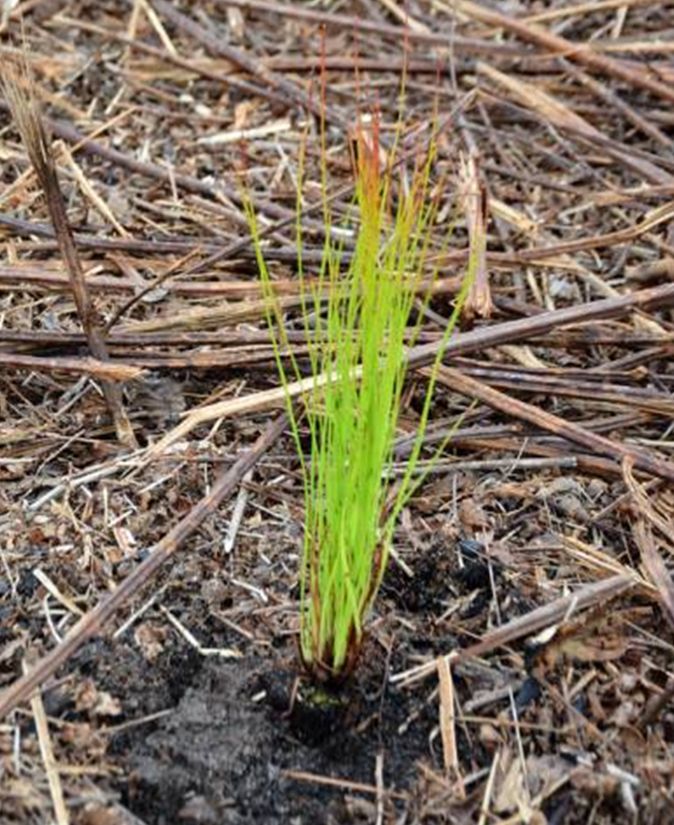
Credit: Working@Duke, Office of Communication Services at Duke University
Planting Density
The number of trees to plant per acre will depend on several factors, including landowner objectives, species selection, survival expectations, and overall budget. Planting more seedlings per acre may increase your odds of having more trees on the site if most of them survive. But if all the trees do survive, it means your trees will start competing with each other at a younger age. Competition between trees can be minimized by thinning stands, but if trees are not large enough (i.e., are unmerchantable), then thinning comes at a cost to the landowner. This is considered “pre-commercial thinning.” Ideally, trees begin to compete at a size that is merchantable so that landowners can generate income from thinning stands, as opposed to losing revenue.
On the other hand, planting lower density stands can be one way to postpone the onset of competition between trees. However, stands of a density that is too low can often yield trees that become very "limby" due to lack of self-pruning and are therefore unsuitable for higher valued products such as sawtimber and poles.
Spacing
Spacing is expressed as the distance between trees by the distance between rows, which is then associated with a total number of trees per acre. For example, a 6x8 tree spacing is 6 feet between trees along a given row and 8 feet between rows for a total of 907 trees per acre (TPA). You can easily calculate the number of seedlings per acre by multiplying the between-seedling spacing by the row width and then dividing the number of square feet per acre (43,560) by that number. For a 6x8 foot spacing, you would divide 43,560/48 = 907 trees per acre.
This spacing example would be considered a high-density planting for most southern pines. However, if a landowner’s objective is to grow trees for a short-pulpwood rotation, this example of spacing might be appropriate, as the quantity of trees would be more important than quality. Alternatively, if you are planting bare-root longleaf pine seedlings on a poor site, this planting density might also be suitable to meet relatively low expectations for seedling survival. Spacing between rows can also help provide space for machines to operate during thinning operations. If spacing between rows it is too narrow, rows may need to be removed to accommodate for machinery, which may result in losses in overall volume growth.
Spacing varies broadly; landowners’ decisions about spacing will be governed by their goals, the species being planted, the type of seedling (bare-root or containerized), and site conditions (Table 6). Thus, spacing decisions are best made in consultation with a professional forester knowledgeable in local timber markets.
Table 6. Seedling spacing and density.
Planting Method
Hand planting and machine planting are the two options for planting pine seedlings. Deciding which method to use will depend mostly on planting site and the landowner’s available resources. Table 7 compares the advantages and disadvantages of both methods. Regardless of planting method, having a written planting contract itemizing planting specifications (including but not limited to seedling transport and handling, planting dates, and conditions for suspending planting) can supplement inspections during planting. A contract will help ensure quality standards are met before payment, which is of particular importance if cost-share programs are providing planting assistance.
Careful supervision for hand planting is a must to ensure crews use appropriate planting practices. Landowners should frequently examine planted seedlings for proper packing to eliminate air pockets and should check distances between planted seedlings for appropriate spacing. Similar observations should be made for machine planting to avoid L-rooting, especially with changing soil types, textures, and moisture levels.
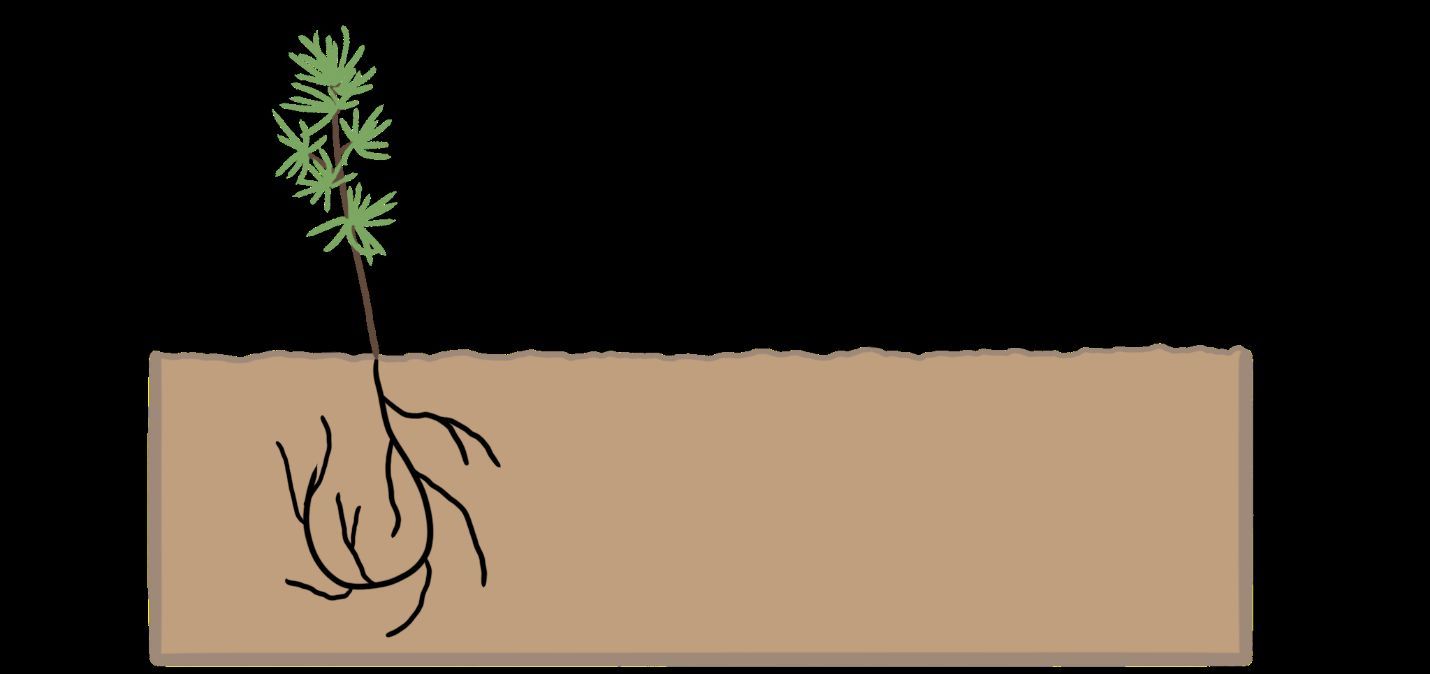
Credit: Natalia Medina-Irizarry
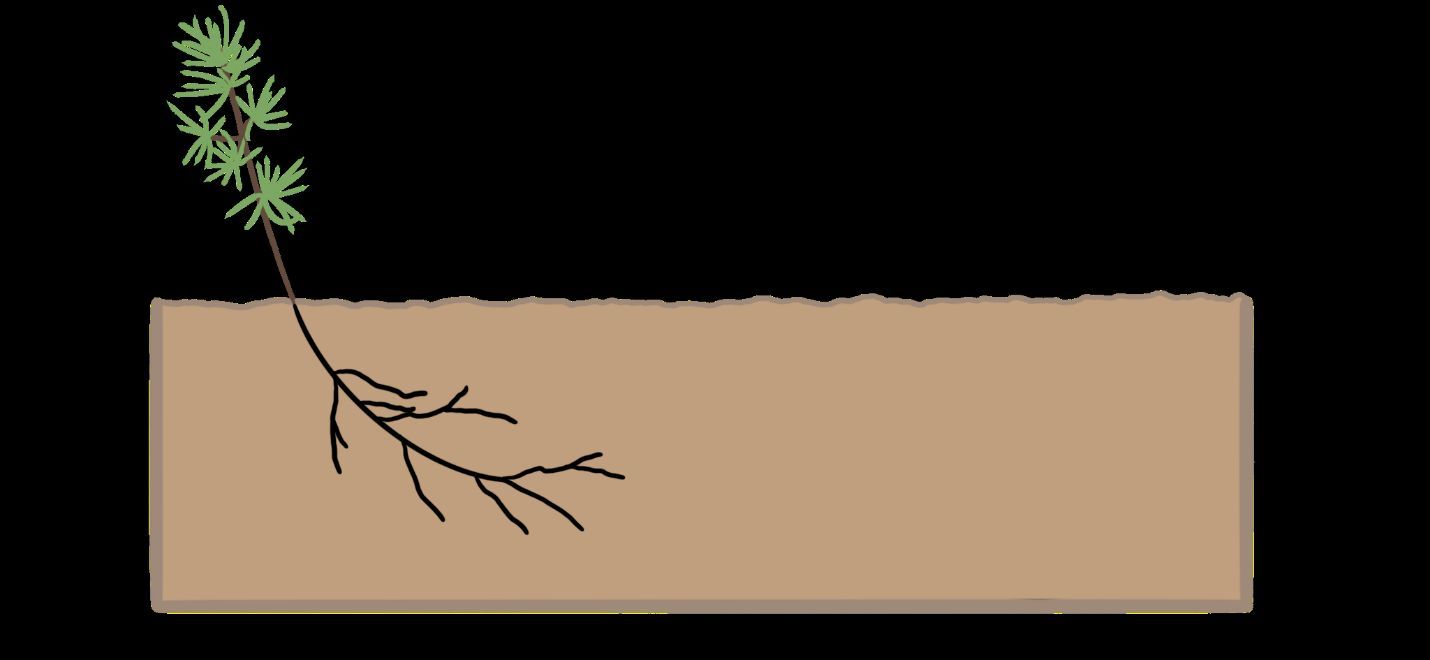
Credit: Natalia Medina-Irizarry
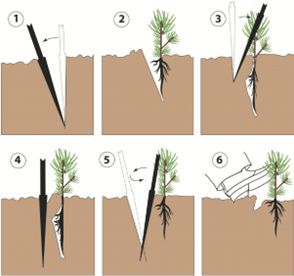
Credit: Elysia Lewis
Table 7.Hand planting vs. machine planting.
Evaluating Young Planted Stands
Stocking
Stocking refers to the distribution and number of living seedlings per unit area (e.g., number of seedlings per acre) or, in some areas, to the percentage of sample plots containing living seedlings (Matney and Hodges 1991). Stocking samples are established during or immediately after planting so that landowners can assess whether the correct number of seedlings has been planted, seedlings have been spaced correctly, and seedlings have been planted appropriately (firmly in the soil). The most efficient way to sample stocking is by systematic sampling in small, circular, fixed-area plots (e.g., 1/100th acre, radius = 11.78 ft). The plots should be uniformly spaced across the planting site, and the total number of live seedlings counted in each plot. These plots should be oriented on lines perpendicular to planting rows.
Survival
Within the first 3 to 5 months after planting, landowners should monitor sites to assess seedling survival. Simply count the living trees in the fixed-area circular plots and determine the percentage of total planted stock alive at the time of counting (Matney and Hodges 1991). Checking for survival early enough allows for adequate time to order more seedlings if needed. Seedlings are then recounted around the end of the first growing season using the same method to establish an average number of surviving seedlings per plot. It is important to check seedling survival within the first year to allow for replanting in bare areas before surviving trees grow too large (Barry 2010). Mapping as you sample each plot will also be helpful for noting precisely which areas may need replanting, as to not rely solely on averages.
Replanting
A landowner’s decision to replant seedlings will be largely influenced by their objectives. Generally, replanting will not be necessary if surveys reveal ≥ 60% survival. Noticeably large areas with poor stocking can be replanted and may require additional site preparation. For example, an area of a plantation may flood shortly after planting, causing high seedlings mortality. Seedlings can be replanted in this entire area to replace lost stock.
If replanting is necessary, avoid interplanting newer seedlings within rows as older, established seedlings will compete more favorably. In the rare occasion that interplanting is required to meet stocking requirements, particularly for stands established under federal incentive programs, plant newer seedlings at least 20ft from established seedlings, though in some cases it may be more financially practical to replant the stand. Controlling weeds with spot herbicide treatments may support survival and growth of interplants. For more information on herbicidal control of competing vegetation, refer to the UF/IFAS publication titled “Considerations for Developing Effective Herbicide Prescriptions for Forest Vegetation Management” (https://edis.ifas.ufl.edu/publication/FR335).
Selecting Species and Species Comparisons
Loblolly, longleaf, shortleaf, and slash pine comprise 90% of the standing pine inventory in the southeastern United States (South et. al 1985). Geographic location limits species choice, given each species’ natural range (discussed later in this publication). Species selection is the crucial first step to planting pines. Determining the appropriate pine and site selection will influence many factors, including:
- Handling and care
- Survival
- Growth
- Yield
Selecting the right species to align with the geographical location and planting site will maximize growth and yield (Table 8); if a species is planted on an inappropriate site, survival and growth will be poor, and product yield will be low. For example, shortleaf pine is more susceptible to littleleaf disease in flood‐prone or poorly drained clay soils and is therefore a poor option on such sites, even if geographically appropriate.
Table 8. Species-site selection guide.
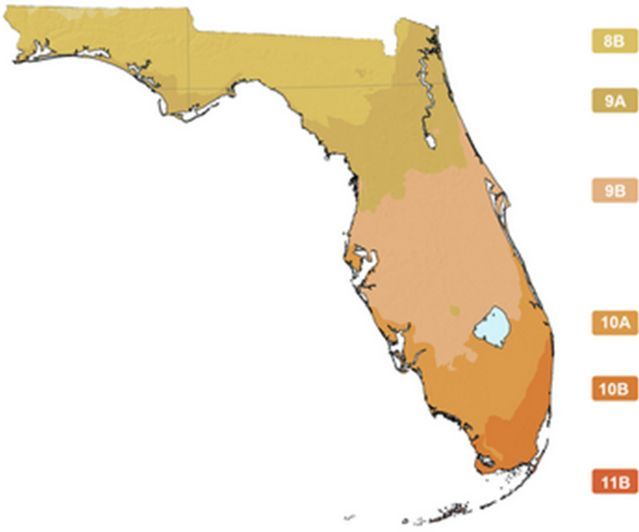
Credit:
Selecting the best species to plant is dependent on several factors such as: geographical region, climate, soil characteristics (e.g., texture, drainage), silviculture system, incidence of pests, landownerobjectives, and proximity to markets (e.g., pulpwood, biomass, sawtimber, veneer).
Southern Pine Markets and Products
Pulpwood
Wood is chipped up and processed to be used for paper production. Smaller-diameter trees are used for pulp production with tree diameters ranging from 4 to 6 inches and up. Wood and form quality is not a concern for this product category, so faster-growing and/or lower quality pines such as loblolly, sand, and slash pines are a good choice for this product. This can be a viable timber objective where short rotation forestry is preferred and when stumpage prices are favorable; stumpage is the price paid to the seller/landowner for the standing wood (on the stump) vs. what the buyer/logger is paid for the wood when delivered to the mill. Pulpwood is often an intermediary product produced during thinning to enhance growth for higher valued, solid wood products. Pulpwood markets are located in the northern half of the state, so this product is generally not a target of production in south Florida. However, south Florida has some mulch and biomass markets that use trees of smaller diameter and lower quality.
Chip-n-Saw
This product uses small to mid-sized trees (8 to 11 inches in diameter). Wood is removed (ground, chipped, sawn) off the sides of logs, leaving a solid wood piece to be sawn into a board – the remaining wood is then used to make other products such as pulp, biomass pellets, and Oriented Strand Board (OSB). The quality of the wood is important, so species that do not tend to grow straight are not favorable. Thus, lower-quality species (e.g., sand pine) are not good choices if chip-n-saw is a target product. As with pulpwood, chip-n-saw is often an intermediary product vs. a primary objective produced during thinning operations. While all pines are potentially suitable for chip-n-saw, species such as loblolly, slash, longleaf, and shortleaf pines are the species of choice.
Poles/Pilings
This product uses larger diameter trees (14 inches and up), and quality is of very high importance. To qualify for pole/piling, the tree must meet standards for straightness, lack of knots, taper, and length. The poles/pilings are not cut into smaller logs but are treated as whole logs of specific lengths. This is a high-valued product. Species well suited for this product as an objective are longleaf, loblolly, slash, and shortleaf pine. It is worth noting that longleaf pine can yield the greatest percentage of pole-quality trees of all the southern pines, making it a good choice where pole markets exist.
Plywood
This product uses larger diameter trees (12 inches and up) and quality (e.g., straightness, few knots) is very important. Logs are put on a lathe and peeled into thin sheets (plys). These sheets are then glued together to produce plywood sheets. Species well suited for this product include longleaf, loblolly, slash, and shortleaf pine. Because plywood is a higher-valued product, proximity to markets is important. Species such as sand pine are low quality and are therefore not a good choice for higher-value wood products. Plywood markets are primarily located in north Florida, so south Florida slash pine is geographically limited for use in this market.
Sawtimber
This product uses larger diameter trees (12 inches and up) and quality (e.g., straightness, few knots) is important. Logs are sawn into boards, and mills often use slabs directly for energy production or chip them and use them to make other products. Species well suited for this product include longleaf, loblolly, slash, and shortleaf pine. Since sawtimber is a higher-valued product, proximity to markets can be greater than for pulpwood. Species such as sand pine are not well suited for producing sawtimber and should not be considered where higher-value timber products are the objective.
Other Products
Biomass: Wood is chipped/ground up and processed for use in energy production or can be further processed into pellets. Typically, the quality of the log is not of concern. In general, smaller trees are used, but size limits range from 4 inches and up to around 20 inches; trees can be too large to be processed by chippers/grinders. Where prices are favorable, biomass can be a target product if short-rotation forestry is the goal. Alternatively, biomass can be an intermediary product that is produced during thinning to enhance growth for higher-valued products.
Christmas trees: Sand pine is the only native pine in Florida grown for production of Christmas trees.
Oriented Strand Board (OSB): This product is an alternative to plywood. Chipped wood is glued together to create a less expensive product. As this product is made from chipped wood, quality is of lesser concern. Proximity to markets is the limiting factor because all pine species are suitable for producing this product.
Pine Straw: Pine straw is simply the needles that fall from pine trees every year. This product can be raked, baled, and sold to garden centers. Pine straw is used by landscapers and homeowners as a mulch or ground cover in gardens and landscaping. Where pine straw markets exist, this can be a very lucrative enterprise. Pine straw can be raked and baled in stands of slash pine or longleaf pine that are eight years of age. Slash and longleaf are the only two Florida pine species that can be baled. The needles of other pines are either too short to be baled or are considered to be of inferior quality for use as mulch or cover. Keep in mind that pine straw management and harvesting can have long-term negative effects on tree growth and soil productivity. Pine needles serve as shelter for the soil and the nutrients required by trees for growth are recycled when needles decompose on the forest floor. When pine needles are removed, the soil becomes more susceptible to erosion and nutrients are removed from the ecosystem. Fertilization is recommended for stands from which pine straw is frequently harvested. Also, intensive pine straw production is not compatible with wildlife habitat objectives as there will be very little groundcover vegetation available for wildlife food.
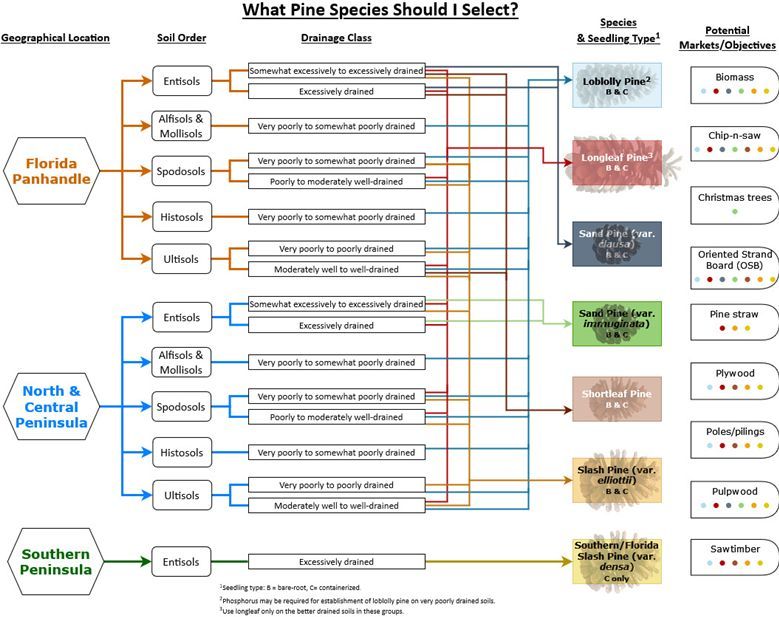
Pine Species
Loblolly Pine (Pinus taeda)
Producing over half the total pine volume in the South, loblolly pine is the most widely planted pine in the region. With the suppression of wildfire, the species has come to prevalence in some parts of Florida that were once dominated by longleaf pine and slash pine. With recent genetic improvements, loblolly pine has become the timber investor and industry standard for planting on new pine plantations in Florida; those searching for the “perfect” seedling for their planting efforts will find an extensive variety of planting stocks available (Gilman et al. 2019a). Loblolly pine can establish on a wide variety of soils (Figure 9). It can be planted on sandy sites underlain by clay, and it grows best on good loam, acid soils.
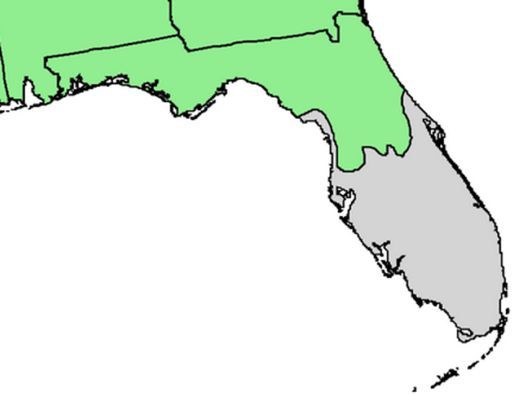
Credit: Wikimedia
Key Points
- Geographic location: Panhandle, north and central Peninsula.
- Soil/site: Histosols, Alfisols, Ultisols, Spodosols.
- Landowner objectives: Chip-n-saw, pilings, plywood, poles, and pulp/paper.
- Proximity to markets:Visit the USDA Forest Service’s Timber Product Outpost Factsheet.
- Seeding type: Bare-root and containerized.
Longleaf Pine (Pinus palustris)
Longleaf pine has been replaced extensively by loblolly and slash pine in its native range for a variety of reasons including: sporadic seed production, difficulty of planting, slow initial growth, susceptibility to competition as a seedling, and fire exclusion (Figure 9). However, the species is making a comeback as landowners who wish to integrate wildlife habitat and timber production objectives find this species to be a good fit, especially where prescribed fire is an important management practice. Longleaf is adapted to fire and well suited in dry, sandy uplands and flatwood sites. Once established, the trees are drought tolerant. This species has a grass stage of development in which minimal height growth occurs (1 – 8+ years). During this phase, longleaf pines develop a deep root system and increase underground reserves. The grass stage can be shortened by using high-quality seedlings, proper planting techniques, and adequate site preparation with herbaceous weed control during the first growing season. The species tends to grow straight and self-prunes, which is ideal for producing high-valued products such as: sawtimber, veneer, and poles.
There are several programs available in select Florida counties that provide landowners with financial and technical assistance to plant longleaf pine; for example, the USDA’s Longleaf Pine Initiative (https://www.nrcs.usda.gov/wps/portal/nrcs/detailfull/national/programs/initiatives/?cid=nrcsdev11_023913) and Working Lands for Wildlife (https://www.nrcs.usda.gov/wps/portal/nrcs/detail/fl/programs/landscape/?cid=stelprdb1266008) work with landowners to restore longleaf pine habitat for wildlife species like gopher tortoises and northern bobwhite quail.
Key Points
- Geographic location: Panhandle, north and central Peninsula.
- Soil/site: Spodosols (on better drained soils), Ultisols, and Entisols.
- Landowner objectives: Habitat restoration, pilings, poles, and sawtimber.
- Proximity to markets:Visit the USDA Forest Service’s Timber Product Outpost Factsheet.
- Seeding type: Bare-root and containerized (most often containerized).
Ocala Sand Pine (Pinus clausa var. clausa) and Choctawhatchee Sand Pine (Pinus clausa var. immuginata)
Sand pine is one of few southern pines with a natural range limited almost exclusively to Florida. Two varieties of sand pine exist in the state: the Ocala sand pine, typically found in north central Florida and spanning southwards along the Gulf and Atlantic coasts; and the Choctawhatchee sand pine, which grows primarily in northwest Florida along the Panhandle. Figure 10 shows the natural ranges of both varieties. As the common name would suggest, sand pine grows best in very sandy, well-drained to excessively drained, nutrient-poor soils.
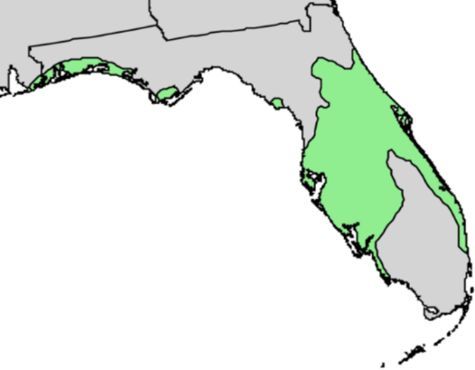
Credit: Wikimedia
Other than the differing climatic conditions in which the two sand pine varieties grow, the only significant difference between them is their cones. Ocala sand pine cones are serotinous and persist closed on tree branches for several years until exposed to fire. The serotinous cones are sealed by the resin from the tree and open when heated. In contrast, the Choctawhatchee sand pine cones are non-serotinous; they open without fire to release seeds.
Key Points
- Geographic location (var. clausa): Panhandle.
- Geographic location (var. immuginata): North and central Peninsula.
- Soil/site: Entisols.
- Landowner objectives (var. clausa): Chip-n-saw, fuel/firewood, habitat restoration, plywood, and pulp/paper.
- Landowner objectives (var. immuginata): Most commonly planted for pulpwood but other objectives include: fuel/firewood, habitat restoration, ornamental.
- Proximity to markets:Visit the USDA Forest Service’s Timber Product Outpost Factsheet.
- Seeding type: Bare-root and containerized; availability is limited each year because only a few nurseries produce seedlings.
Shortleaf Pine; Yellow Pine (Pinus echinata)
Shortleaf pine is planted across most of the southeastern United States, but its natural range in Florida is restricted to a very small area in the Panhandle (Figure 11). Few private landowners plant shortleaf pine in Florida, preferring to plant faster growing and more widely available loblolly or slash pine seedlings. However, recent federal restoration efforts have stimulated an increase in planted shortleaf pine acreage across the species’ range. Shortleaf pine is very adaptable to certain soil types but grows best on moist, well-drained, deep, sandy, or silty loam soils.
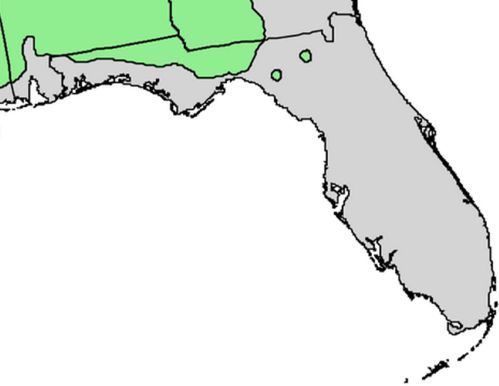
Credit: Wikimedia
Key Points
- Geographic location: Panhandle.
- Soil/site: Ultisols and Entisols.
- Landowner objectives: Chip-n-saw, plywood, poles, pulp/paper, and sawtimber.
- Proximity to markets:Visit the USDA Forest Service’s Timber Product Outpost Factsheet.
- Seeding type: Bare-root and containerized.
Slash Pine (Pinus elliottii var. elliottii) and Southern Slash Pine (Pinus elliottiivar. densa)
Over the past century, slash pine has been planted, grown, and harvested across millions of acres throughout Florida. Two varieties of this species are native to Florida: slash pine (Pinus elliottii var. elliottii) and Southern (or south Florida) slash pine (Pinus elliottii var. densa). The two varieties differ not only in geographical location, but also in seedling development and wood density. Slash pine (var. elliottii) is the variety found throughout most of the state, predominantly in north and central Florida. Southern slash pine (var. densa) is the variety found in the southernmost parts of the state; this variety is of denser wood and, has a juvenile “grass phase” comparable to that of the longleaf pine (Pinus palustris). It differs morphologically in that it has smaller cones and needles that are concentrated mostly in fascicles of two vs. twos and threes.
As with loblolly pine, slash pine can be found on a variety of soil types (see Figure 12 for natural range). Southern slash pine is commonly found on thin limestone soils in Dade and Monroe counties but occurs on deeper acidic soils in south central Florida. Southern slash pine (var. densa) is more tolerant of fire. Stands of either slash variety tend to stagnate if not thinned early to maintain adequate crown development; pine growth is enhanced by adequate site preparation and removal of understory competition, hardwoods and saw palmetto (Serenoa repens).
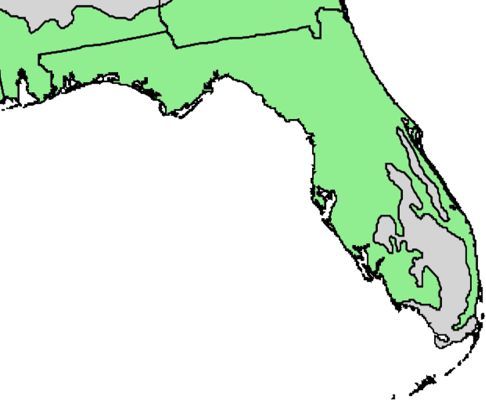
Credit: Wikimedia
Key Points
- Geographic location (var. elliottii): Panhandle, north and central Peninsula.
- Geographic location (var. densa): Southern Peninsula.
- Soil/site (var. elliottii): Histosols, Alfisols, Ultisols, Spodosols, and Entisols.
- Soil/site (var. densa): Entisols.
- Landowner objectives (var. elliottii): Fuel/firewood, habitat restoration, poles, pulp/paper, and sawtimber.
- Landowner objectives (var. densa): Fuel/firewood, habitat restoration, pilings, poles, pulp/paper, and sawtimber.
- Proximity to markets:Visit the USDA Forest Service’s Timber Product Outpost Factsheet.
- Seeding type: Bare-root and containerized; southern slash variety containerized.
Other Pines of Florida
Of honorable mention are two additional native pines founds in Florida, spruce pine and pond pine. Both species can be found in nurseries, but neither species is found commercially, nor are these pines planted on a broad scale. Spruce and pond pine are introduced here briefly but will not be considered in detail for commercial planting.
Spruce pine (Pinus glabra)
Spruce pine is found naturally in hardwood hammocks, spanning northward of Alachua County and westward into the Panhandle (Figure 13). The trees grow best in moist, sandy loam soils, and spruce pine is one of few pines that grows naturally in shade. Spruce pine cannot be intermixed with other southern pine species in lumber manufacturing due to radically different drying rates. Though not of particular interest in Florida markets, spruce pine is often used for large timbers and beams and is sometimes used for pulp, fuelwood, and sawtimber.
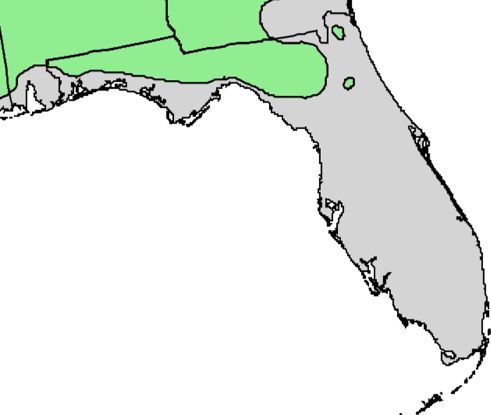
Credit: Wikimedia
Pond Pine (Pinus serotina)
Pond pine grows in poorly drained flatwoods near bayheads and pond edges on moist–wet sites (Figure 14). The tree is often mistaken for loblolly pine due to similar appearance, but pond pine is rarely grown commercially as it is not of particular value for wood products. Larger trees may occasionally be harvested for pulpwood.
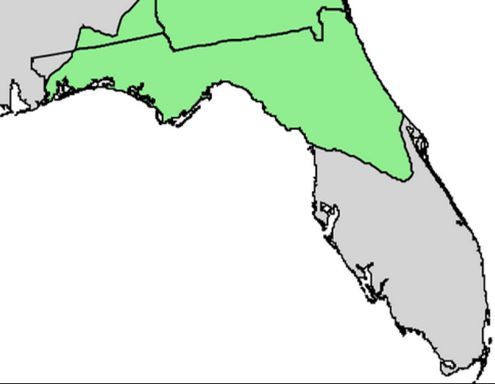
Credit: Wikimedia
For a quick comparison of the southern pine species traits, see Table 9.
Table 9.Pine species tolerances/trait comparison1.
Genetically Improved Pines/Varieties
Some of the forest health threats previously discussed for each species have been mitigated by genetic improvement, a selection process that has improved pine resistances to certain pests and diseases. Planting genetically improved varieties of pines can increase the health, productivity, and value of Florida timberlands. (Improved varieties are hardy, but they are still vulnerable to poor silvicultural practices.) Landowners and planters ought to continue to use well-grown seedlings, select the appropriate species per site characteristics, properly prepare planting sites, and handle seedlings and execute planting with care. When these best management practices are used in conjunction with genetically improved seedlings, plantation growth, yield, and value increase substantially.
Genetically improved varieties of loblolly pine, slash pine (var. elliottii), and longleaf pine are accessible to landowners at certain forest tree nurseries across the state. Refer to Figure 15 for a map of notable nurseries and tree seedling suppliers in Florida and within 100 miles of the state border. For more information on genetically improved pines see UF/IFAS publication Genetically Improved Pines for Reforesting Florida's Timberlands, https://edis.ifas.ufl.edu/publication/FR007.
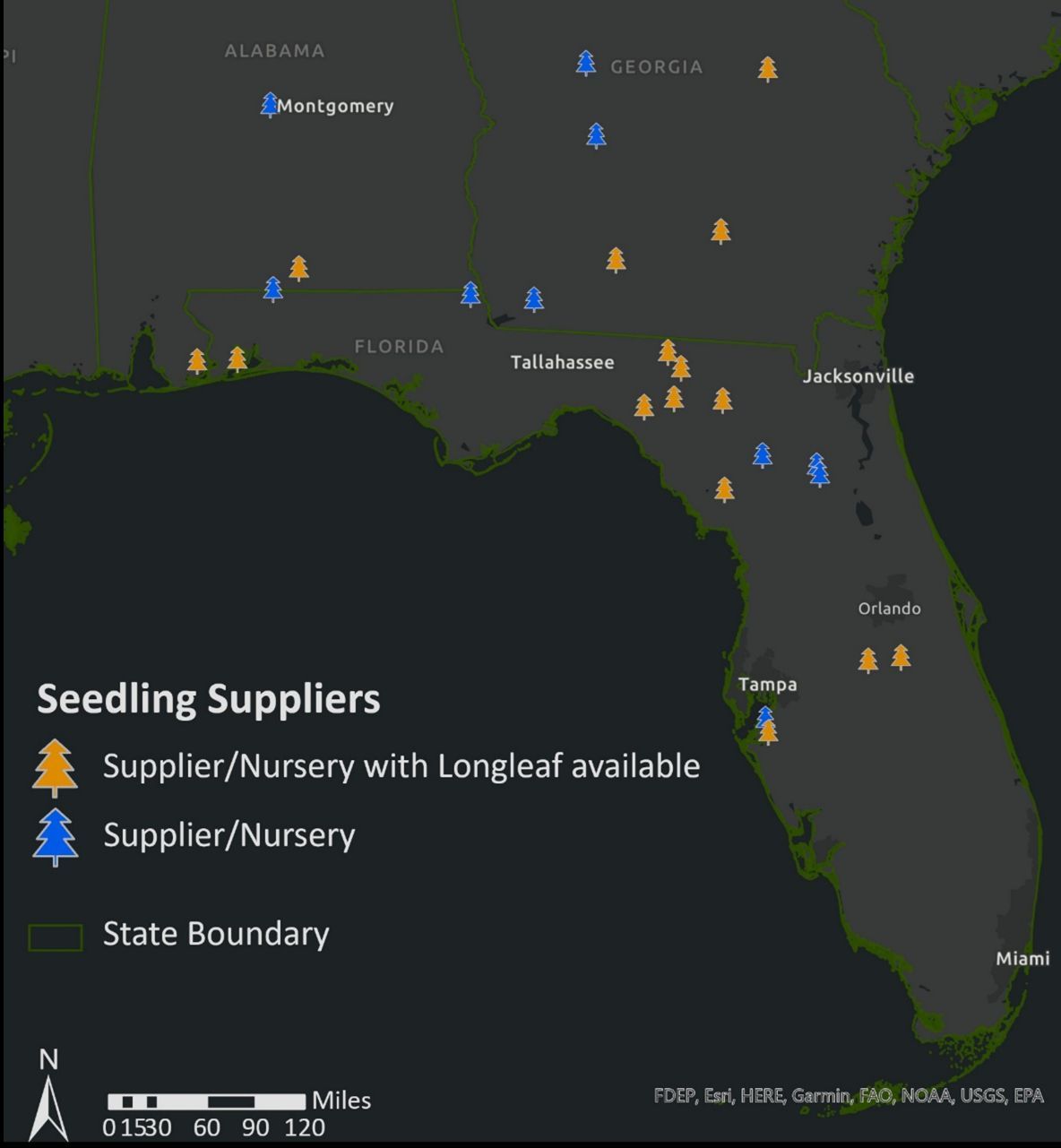
Credit: Southern Group of State Foresters. Map created by Natalia Medina-Irizarry
References
Balmer, W. E., and H. L. Williston. 1974. Guide for Planting Southern Pines. Department of Agriculture, Forest Service, Southeastern Area, State and Private Forestry.
Barry, J. E. 2010. Storing, handling and planting southern pine seedlings. https://www.uaex.uada.edu/environment-nature/forestry/managing-woodlands/FSA-5007.pdf
Collins, M. E. 1985. Key to Soil Orders in Florida. Fact sheet SL-43. Soil and Water Science Department, Florida Cooperative Extension Service, Institute of Food and Agricultural Sciences, University of Florida. First published: August. http://ufdc.ufl.edu/IR00003421/00001
Ezell, A. W., D. J. Moorhead, and A. J. Londo. 2001. “Planting Southern Pines: A Guide to Species Selection and Planting Techniques.” Mississippi State University Extension Service, Publication 1776. 15p.
Gilman, E, D. G. Watson, R. W. Klein, A. K. Koeser, D. R. Hilbert, and D. C. McLean. 2019a. “Pinus taeda: Loblolly Pine.” ENH-637. EDIS 2019. https://edis.ifas.ufl.edu/publication/ST478
Gilman, E, D. G. Watson, R. W. Klein, A. K. Koeser, D. R. Hilbert, and D. C. McLean. 2019b. “Pinus elliottii: Slash Pine.”ENH-622. EDIS 2019. https://edis.ifas.ufl.edu/publication/ST463
Londo, A. J., and S. G. Dicke. 2005. Measuring Survival and Planting Quality in New Pine Plantations. Southern Regional Extension Forestry, University of Georgia. https://www.srs.fs.usda.gov/pubs/gtr/gtr_se057.pdf
Matney, T. G., and J. D. Hodges. 1991. “Evaluating Regeneration Success.” In Forest regeneration manual (pp. 321–331). Springer, Dordrecht. https://doi.org/10.1007/978-94-011-3800-0_18
Mylavarapu, R., W. Harris, and G. Hochmuth. 2019. “Agricultural Soils of Florida.” SL-441. EDIS 2019. https://edis.ifas.ufl.edu/publication/ss655
Nadel, R. L., S. Enebak, and B. Barlow. 2020. “Planting Southern Pine Seedlings.” Alabama Cooperative Extension System. https://www.aces.edu/blog/topics/forestry/planting-southern-pine-seedlings/
South, D. B., J. N. Boyer, and L. Bosch. 1985. “Survival and Growth of Loblolly Pine as Influenced by Seedling Grade: 13-Year Results.” Southern Journal of Applied Forestry 9 (2): 76–81. https://doi.org/10.1093/sjaf/9.2.76
Taylor, E. L., M. Blazier, and A. G. Holley. 2007. “New Pine Planting Strategies for the Western Gulf States.” In: National Proceedings: Forest and Conservation Nursery Associations-2006. Edited by L. E. Riley, R. K. Dumroese, and T. D. Landis, Proceedings RMRS-P-50. Fort Collins, CO: US Department of Agriculture, Forest Service, Rocky Mountain Research Station. p. 104–109. https://www.fs.usda.gov/treesearch/pubs/30899
Wakeley, P. C. 1954. Planting the southern pines (No. 18). Forest Service, US Department of Agriculture.